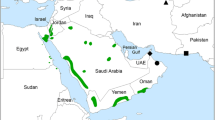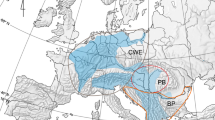Abstract
Biosphere reserves have been established around the world as a means to protect sensitive or threatened ecoregions and the biodiversity within them. As such, the organisms occurring within these reserves are important from a conservation perspective as they often represent endemic species or remnant populations. Here we provide genetic evidence of widespread occurrence of Xiphophorus helleri within the Metztitlán Canyon Biosphere Reserve in Hidalgo, Mexico. One nuclear and two mitochondrial genes were sequenced from four populations within the canyon and confirmed that the specimens collected were X. hellerii. When compared to published sequences of X. hellerii from multiple localities within the documented natural range of the species, the specimens from Metztitlán were found to exhibit between 0 and 1.6 % sequence divergence. Possible scenarios for colonization of the canyon and conservation implications are discussed.
Similar content being viewed by others
References
Basolo AL (1990) Female preference for male sword length in the green swordtail, Xiphophorus helleri (Pisces: Poeciliidae). Anim Behav 40:332–338
CONANP (2003) Programa de manejo Reserva de la Biosfera Barranca de Metztitlán, 1st edn. Comisión Nacional de Areas Naturales Protegidas, Mexico, 209 pp
Culumber ZW, Fisher HS, Tobler M, Mateos M, Barber PH, Sorensen MD, Rosenthal GG (2011) Replicated hybrid zones of Xiphophorus swordtails along an elevational gradient. Mol Ecol 20:342–356
Ibáñes-Aguirre AL García-Calderón JL, Pérez-Rojas A, Alvarez-Hernández S, Alvarez-Silva C Núñez-Portugal E (2002) El lago de Metztitlán, Hidalgo. In de la Lanza-Espino G, García-Calderón JL (eds.) Lagos y Presas de México. AGT Editor S.A., Distrito Federal, México Pages 259–268 680 pp
Jones CP, Johnson JB (2009) Phylogeography of the livebearer Xenophallus umbratilis (Teleostei: Poeciliidae): glacial cycles and sea level change predict diversification of a freshwater tropical fish. Mol Ecol 18:1640–1653
Kallman KD, Kazianis S (2006) The genus Xiphophorus in Mexico and Central America. Zebrafish 3(3):271–285
Meyer A, Morrissey JM, Schartl M (1994) Recurrent origin of a sexually selected trait in Xiphophorus fishes inferred from a molecular phylogeny. Nature 368:539–542
Meyer A, Salzburger W, Schartl M (2006) Hybrid origin of a swordtail species (Teleostei: Xiphophorus clemenciae) driven by sexual selection. Mol Ecol 15:721–730
Miranda R, Galicia D, Monks S, Pulido-Flores G (2012) Diversity of freshwater fishes in Reserva de la Biosfera Barranca de Metztitlán, Hidalgo, Mexico, and recommendations for conservation. Southwest Nat 57:285–291
Monks S, Zaráte-Ramírez VR, Pulido-Flores G (2005) Helminths of freshwater fishes from the Metztitlán Canyon Reserve of the Biosphere, Hidalgo, Mexico. Comp Parasitol 72(2):212–219
Obregón-Barboza H, Contreras-Balderas S, Lozanovilano ML (1994) The fishes of northern and central Veracruz, Mexico. Hydrobiologia 286:79–95
Poort MJ, Whipps CM, Watral VG, Font WF, Kent ML (2006) Molecular characterization of a Mycobacterium species in non-native poeciliids in Hawaii using DNA sequences. J Fish Diseases 29:181–185
Rosenthal GG, Evans CS (1998) Female preferences for swords in Xiphophorus helleri reflects a bias for large apparent size. Proc Natl Acad Sci 95:4431–4436
Rosenthal GG, De La Rosa Reyna XF, Kazianis S, Stephens MJ, Morizot DC, Ryan MJ, De Leon FJG (2003) Dissolution of sexual signal complexes in a hybrid zone between the swordtails Xiphophorus birchmanni and Xiphophorus malinche (Poeciliidae). Copeia: 299–307
Royle NJ, Lindstrom J, Metcalfe NB (2008) Context-dependent mate choice in relation to social composition in green swordtails Xiphophorus helleri. Behav Ecol
Simmons LW, Beveridge M, Evans JP (2008) Molecular evidence for multiple paternity in a feral population of green swordtails. J Hered 99(6):610–615
Tatarenkov A, Healey CIM, Grether GF, Avise JC (2008) Pronounced reproductive skew in a natural population of green swordtails, Xiphophorus helleri. Mol Ecol 17:4522–4534
Walling CA, Royle NJ, Lindstrom J, Metcalfe NB (2008) Experience-induced preference for short-sworded males in the green swordtail, Xiphophorus helleri. Anim Behav 76(2):271–276
Wischnath L (1993) Atlas of livebearers of the world. T. F. H. Publications, Inc., New Jersey, 336 p
Acknowledgments
We are grateful to CONANP (Comisión Nacional de Áreas Naturales Protegidas) and the Administration of the Reserva de la Barranca de Metztitlán Reserva de la Biosphera for the opportunity to work within the reserve. The authors extend a special thanks to Señor Andrés López-Morales, former brigadista of the Reserve, who was our field guide during collection of the fish and whose knowledge of the area greatly facilitated the work. Gil G. Rosenthal (Texas A&M University, College Station, Texas), principal investigator of scientific research, Centro de Investigaciones Científicas de las Huastecas “Aguazarca” (CICHAZ- http://www.cichaz.org/), who allowed us to use the facilities at the field station and provided valuable information about species of Xiphophorus in Hidalgo. This work was supported by a Consejo Nacional de Ciencia y Tecnología (CONACyT) (Clave 0127310) grant in basic science to SM, project CGL2006-02844/BOS from the Plan Nacional de Investigación y Desarrollo en Innovación I+D+I (2004–2007), Dirección General de Investigación, Ministerio de Ciencia e Innovació́n, Gobierno de España, European Regional Development Fund to RM, and a scholarship to Christian Bautista-Hernández (254023). This work followed all local animal ethics regulations.
Author information
Authors and Affiliations
Corresponding author
Rights and permissions
About this article
Cite this article
Culumber, Z.W., Monks, S. & Miranda, R. Report of Xiphophorus hellerii in the arid Metztitlán Canyon Biosphere Reserve in Mexico. Environ Biol Fish 97, 157–161 (2014). https://doi.org/10.1007/s10641-013-0135-5
Received:
Accepted:
Published:
Issue Date:
DOI: https://doi.org/10.1007/s10641-013-0135-5




